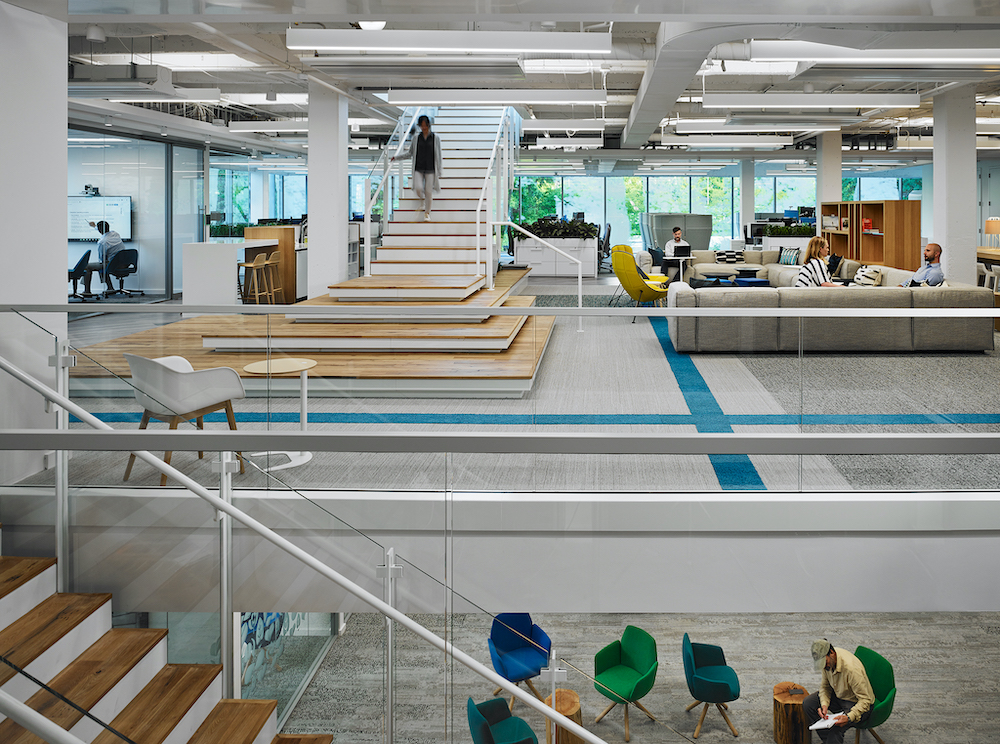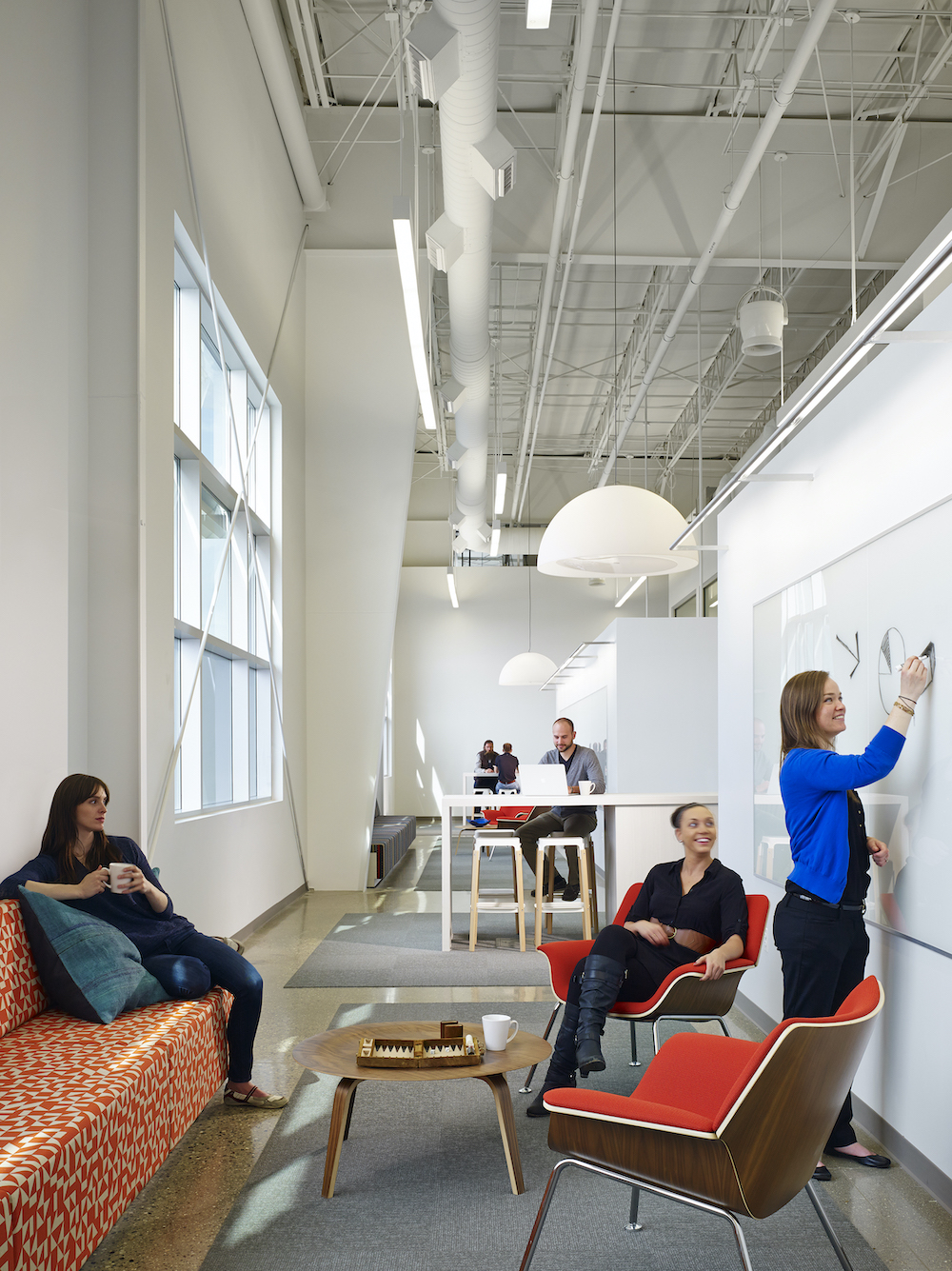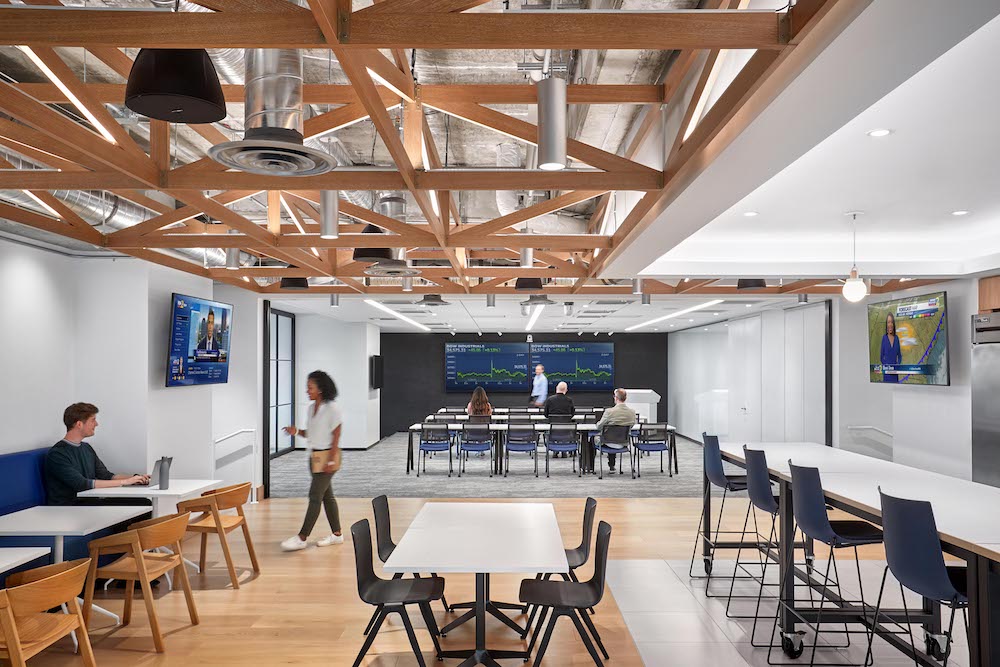Perkins&Will’s Kim Rousseau takes a look at what today’s workplace design practitioners can learn from an 80-year-old theory of human psychology.
As a lifelong academic who spent his four-decade-long career in university classrooms and research labs, the famed mid-20th Century psychologist Abraham Maslow never worked in a corporate office and most likely never even set foot in one.
Still, 80 years later, his famed 1943 “Hierarchy of Needs” theory provides a prescient lens for looking at today’s most pressing workplace design challenges.
Hierarchy of Workplace Needs
Typically depicted as a visual in the form of a pyramid with five tiers, Maslow’s theory holds that human motivation is based on the pursuit of five different levels of needs beginning with the most basic physiological needs (food, water, safety/security, etc.) and then expanding to include psychological needs like “belongingness,” love and feelings of prestige and accomplishment. Finally, if each of these more basic needs are being met, humans can then be motivated to achieve higher-level goals and, ultimately, what Maslow termed “self-actualization,” the achievement of one’s full potential.
Practitioners of modern-day human-centered workplace design, whether they’re familiar with Maslow or not, often approach their work with a similar basis of understanding. Simply put, if workers’ most basic needs aren’t being met—if they’re too hot or cold, if it’s too noisy, or if glare from the sunlight is making it difficult for them to read their computer screens—they won’t be motivated (or even psychologically able) to succeed in higher-level work-related tasks.
In the early days of the pandemic and the subsequent early stages of “return to office,” the focus was squarely on these kinds of base-level health and wellness concerns (ie, the bottom of Maslow’s pyramid): Was there ample space for social distancing? Was there sufficient ventilation? How were shared spaces to be utilized safely?

It was a significant step backward for the workplace because, in the years immediately prior, the corporate world had finally reached the point of orienting office designs toward the very top of the pyramid, creating spaces that helped workers develop and maximize talents, heighten creativity and pursue big-picture goals and healthy, balanced lifestyles.
While those goals can, should and do remain as the aspiration of any/all meaningful workplace design ideations happening today, the lessons we’ve collectively learned during this ongoing return-to-office phase should adjust our focus more intently toward the middle of the pyramid into the foreseeable future.
After a prolonged (in some cases, multi-year) period of work-from-home isolation, the office worker’s middle-of-the-pyramid need for community, belongingness and the resulting feelings of acceptance, respect and love has never been greater. As Maslow himself observed, human beings are social creatures who yearn for positive social interaction and the benefits that come from it.
So how can organizational leaders and workplace designers work together to develop workplaces and a workplace culture that meets this moment? With this Maslowian framework in mind, taking our cues from the family and from the spiritual world would seem fitting.

Family Inspiration
Families, as we know, draw their strength in large part from generational influence and modeling: parent-to-child, grandparent-to-grandchild, older-sibling-to-younger-sibling. Are our workplaces designed to foster like-kind relationships among coworkers? Practically speaking, are there an ample amount of socially driven spaces where people from different generations (Baby Boomers, Gen X’ers, Millennials and Gen Z’ers) can come together for informal mentoring opportunities and to learn by experiencing. (Note: This isn’t a one-way street: Boomers and Gen Xers have just as much to learn from their younger colleagues as visa-versa.)
The family home, where so many of us have become highly accustomed to working (to the undeniable detriment of the office), provides a useful inspiration for this type of work environment. Are you looking for intense privacy? Retreating to your bedroom and closing the door is the most likely solution. On the contrary, living rooms and other such areas are largely social in nature, but also provide quiet pockets for more intimate one-to-one interactions. At the far end of the spectrum, of course, are kitchens: filled with movement, high-energy, a multitude of different activity types and larger full-family-sized interactions like meals.
Does your workplace pay deference to all three types of spaces? Does it enable free movement and the ability for team members to shift to different types of workspaces depending on the time of day, task at hand or even their mood? Now more than ever, workplace design professionals need to think in terms of radically human-based solutions that create opportunities for workers to come together, draw inspiration from one another, have fun(!) and reestablish social connections (without abandoning practical, base-level considerations like acoustics and the need for at least occasional privacy).

Spiritual Inspiration
As previously mentioned, the best traditions of the spiritual world provide another helpful guide. Specifically, how can workplaces enable the individual to shift their focus outward toward the well-being of others and the community at large.
In a trend that was ushered in by Silicon Valley tech firms beginning in the early 2000s (some would argue, for less-than-altruistic reasons) countless organizations from all sectors have sought to create the artifice of community with in-house cafes and bars staffed by baristas and mixologists, workout/leisure facilities, and even breakfast, lunch and dinner service—all within their own four walls.
What if our next generation of office designs instead look to push people out into the community for these community–based activities? What if office buildouts are actually smaller and organizations look to engage with hotels, restaurants and co-working facilities—all entities that are vital to a community’s wellbeing but have struggled since the beginning of the pandemic—when planning larger meetings or client entertainment? And to take that thought another step further, what if we looked to repurpose vacant office space (or even entire office buildings) for these types of communal uses?

Let’s stop trying to replicate community within the four walls of an office and think about designing office spaces to be a part of the actual community at large.
In conclusion, the concept of a well-designed workplace acting to hasten its occupants’ “self-actualization” remains as an aspirational goal for all mission-driven workplace professionals, regardless of whether they subscribe to Maslow’s worldview, or even know his name. But in this current protracted “return-to-office” paradigm, attention should be given first and foremost to more basic human needs—specifically our hunger for positive, joyful and life-affirming social interaction.


